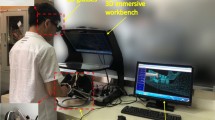Abstract
Immersion and interaction are two key features of virtual reality systems, which are especially important for medical applications. Based on the requirement of motor skill training in dental surgery, haptic rendering method based on triangle model is investigated in this paper. Multi-rate haptic rendering architecture is proposed to solve the contradiction between fidelity and efficiency requirements. Realtime collision detection algorithm based on spatial partition and time coherence is utilized to enable fast contact determination. Proxy-based collision response algorithm is proposed to compute surface contact point. Cutting force model based on piecewise contact transition model is proposed for dental drilling simulation during tooth preparation. Velocity-driven levels of detail haptic rendering algorithm is proposed to maintain high update rate for complex scenes with a large number of triangles. Hapticvisual collocated dental training prototype is established using half-mirror solution. Typical dental operations have been realized including dental caries exploration, detection of boundary within dental cross-section plane, and dental drilling during tooth preparation. The haptic rendering method is a fundamental technology to improve immersion and interaction of virtual reality training systems, which is useful not only in dental training, but also in other surgical training systems.
Similar content being viewed by others
References
Kenneth S, Francois C, Federico B. Haptic rendering: introductory concepts. IEEE Comput Graph, 2004, 24(2): 24–32
Srinivasan M A, Basdogan C. Haptics in virtual environments: taxonomy, research status, and challenges. Comput Graph, 1997, 21(4): 393–404
Saddik A E. The potential of haptics technologies. IEEE Instru Meas Mag, 2007, 10(1): 10–17
Hollerbach J. Some current issues in haptics research. In: Proceedings of the 2000 IEEE International Conference on Robotics and Automation. Salt Lake City: IEEE, 2000. 757–762
Luciano C, Banerjee P, Florea L, et al. Design of the immersiveTouch: a high-performance haptic augmented virtual reality system. In: 11th International Conference on Human-Computer Interaction. Las Vegas, 2005. 22–27
Wang D, Zhang Y, Wang Y H, et al. Cutting on triangle mesh: local model based haptic display for dental preparation surgery simulation. IEEE Trans Visual Comput Graph, 2005, 6: 671–683
Li M, Liu Y H. A virtual endodontics test bed for training root canal skills. In: Proceedings of 2004 IEEE International Conference on Robotics and Automation, ICRA’04. Vol 1. HongKong, 2004. 841–846
Hoppe H. Progressive meshes. In: Proceedings of Siggraph’96. 1996. 99–108
Zhou K, Pan Z G, Shi J Y. Smooth transition between levels of detail of models. J Comput Aid Des Comput Graph, 2000, 12(6): 463–467
He H G, Jian J, Zhang X P, et al. A survey on mesh simplification. J Softw, 2002, 13(12): 2215–2224
Asano T, Ishibashi Y. Adaptive display control of exhibits in a distributed haptic museum. In: the 3rd IEEE International Workshop on Haptic, Audio and Visual Environments and Their Applications. Washington: IEEE, 2004. 19–23
Lin M C, Gottschalk S. Collision detection between geometric models: a survey. In: Proceedings of IMA Conference on Mathematics of Surfaces. 1998. 37–56
El-Sana J, Varshiney A. Continuously-adaptive haptic rendering. Virt Envir, 2000, 135–144
Otaduy M A, Lin M C. Sensation preserving simplification for haptic rendering. ACM Trans Graph, 2003, 22(3): 543–553
Liu P, Shen X J, Georganas N. Multi-resolution modeling and locally refined collision detection for haptic interaction. In: Proceedings of the Fifth International Conference on 3-D Digital Imaging and Modeling (3DIM’05). IEEE, 2005. 581–588
Zhang J, Payandeh S, Dill J. Haptic subdivision: an approach to defining level-of-detail in haptic rendering. In: Proceedings of the 10th Symposium. Haptic Interfaces for Virt Environ Teleop Syst(HAPTICS.02). IEEE, 2002. 201–208
Mor A B. Progressive cutting with minimal new element creation of soft tissue models for interactive surgical simulation. PhD Dissertation. Pittsburgh: The Robotics Institute, Carnegie Mellon University, 2001. 19–26
Wu J, Song A, Li J Q. A quick physics-based deformation model and real-time force reflection algorithm. In: Proceedings of International Conference on Information Aquisition. 2004. 327–330
Song A G, Yuan K, Fu Y J. Haptic modeling and rendering based on neurofuzzy rules for surgical cutting simulation. Acta Automat Sin, 2006, 32(2): 193–199
Zilles C B, Salisbury J K. A constraint-based god object method for haptics display. In: Proceedings IEEE/RSJ International Conference on Intelligent Robots and Systems. Pittsburgh, 1995. 146–151
Colgate J E, Brown J M. Factors affecting the Z-width of a haptic display. In: Proceedings IEEE International Conference on Robotics and Automation. Los Alamitos, 1994. 3205–3210
Liu G, Zhang Y, Townsend W T. Force modeling for tooth preparation in a dental training system. Virt Real, 2008, 12(3): 125–136
Author information
Authors and Affiliations
Corresponding author
Additional information
Supported by National Natural Science Foundation of China (Grant Nos. 60605027, 50575011), National High-Tech Research & Development Program of China (Grant No. 2007AA01Z310)
Rights and permissions
About this article
Cite this article
Wang, D., Zhang, Y., Wang, Y. et al. Haptic rendering for dental training system. Sci. China Ser. F-Inf. Sci. 52, 529–546 (2009). https://doi.org/10.1007/s11432-009-0062-4
Received:
Accepted:
Published:
Issue Date:
DOI: https://doi.org/10.1007/s11432-009-0062-4




